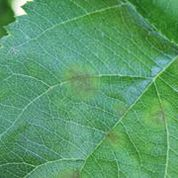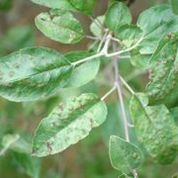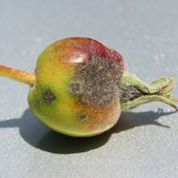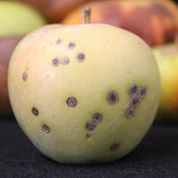Introduction to Apple Scab
Apple scab is the most common disease of apple. Venturia inaequalis favors moderate temperatures and rainy spring weather.
If these conditions are met during leaf emergence and bloom, infection can be severe. Initial infections are caused by fungal
spores from overwintering fungus in leaf litter.
Initial infections are caused by sporulation from overwintering fungi. If these spores are allowed to infect (i.e. fungicide
program not implemented), secondary spores develop in scab lesions. These secondary spores are capable of producing thousands of
new disease lesions. Thus, growers should focus on control of initial spring infections before secondary repeating spores can form.
Leaf infection.
Leaves can become infected by initial spores or by secondary spores. Scab lesions appear as greenish brown, velvety lesions without
defined borders (Figure 1). Eventually, lesion tissue thickens and bulges outward (Figure 2). Leaves may become yellow and fall from trees.
Fruit infection.
Fruit can become infected by either spore type. Lesions appear greenish black, velvety, and have clearly defined borders (Figure 3).
As scab lesions mature, they darken and become corky or scabby and crack (Figure 4). Infected fruit may become deformed and may drop prematurely.
Fruit become less susceptible to infection as they mature.
More information on apple scab can be found in:
PPFS-FR-T-13
Spray recommendations for commercial growers
ID232
and homeowners
ID-21
are also available online.




Figure 1. Scab lesions initially appear as greenish-brown, velvety lesions without defined borders.
Figure 2. Scab lesion tissue eventually thickens and bulges outward.
Figure 3. Lesions on fruit appear greenish-black and velvety.
Figure 4. Fruit lesons become corky and crack.
Notes
Risk for apple scab is typically from tight cluster until 2 weeks after petal fall. However, the majority of spores are released by first cover.
Prediction model is based the previous 7 days of accumulated leaf wetness and temperature to estimate risk for spore release and infection.
Instructions
• Select county from drop-down menu using arrows.
• Select today's date to determine current risk for apple scab. Other dates may be entered if assessment of past risk is warranted.
• Determine orchard history.
• Click 'submit choices'.
These data are based on the 24 hour period 7 PM to 7 PM
Data should NOT BE USED FOR LEGAL PURPOSES.